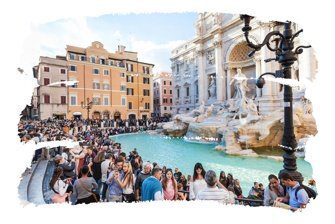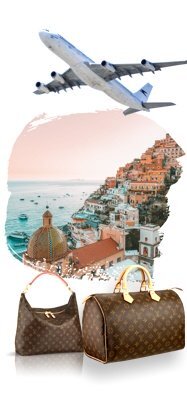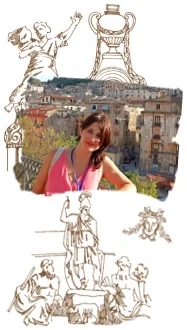What to see in Calcata?
With its just over 900 inhabitants, Calcata is a very private little town! The remnants of human presence, in the area where today Calcata is located, date back to prehistoric times. There, on a hill near Narce, numerous objects and signs of life related to the most ancient phases of the Etruscan-Paliscan civilization were found. Let’s get to our post of the day! Shall we visit Calcata village in Virtebo? Here at Your Travel to Italy with Ana Patriciayou make the trip of your dreams!!! ALSO: see our “Accommodation in Italy – Tips for your holidays!”
Video about Calcata, in Virtebo (by drone)
(Surce: The AI Nomad)
A little about Calcata…
Just 40 km from Rome, we can make a detour to this village. When we get here, time just seems to have stopped for centuries, and as you walk through the city’s streets, you’ll find craft workshops and shops, tea houses, bars and restaurants. With ease, you come across artists, who do their arts with peace of mind, sitting in front of their house or at the gates of their studios. You will soon notice how clean and well-kept the city is! The village is winded by arches and stairs, which, depending on the angle, offer us – often – beautiful views of the valley, dense with trees and woods. Calcata rises on the tip of a huge rock, as if suspended in mid air. On the streets, you will always find a cordial and festive atmosphere, light, fun, almost magical and poetic!
The main entrance
Calcata is ‘mounted’ on a tufa buttress, preceded by a monumental entrance door that leads inside. There ‘inside’, houses and buildings, as a whole, are presented with homogeneous to harmonic colors, with a ‘stone gray’ that sets the tone for their surroundings and flowers in the windows that delight our eyes (curiosity: some flowers are artificial ! It’s worth the game of observing them with affection to know how to differentiate them!).
1) What to see in Calcata? VISIT THE CITY COUNCIL AND THE BARONIAL CASTLE
Let’s start with the beautiful main square that opens in front of you with the City Council and the Baronial Castle – from the 13th century, built by the Anguillara. There we also saw the monument in memory of the fallen in World War II. The series of observation towers allow a first glimpse of the outside.
2) What to see in Calcata? VISIT GRANARONE
In addition, visit the Granarone, an old barn from 1670. Saved from decay after 1950 and restored, it now serves as the seat of a cultural association. Small in size, but immense in culture, history and warmth. This place will enchant you!
3) What to see in Calcata? VISIT THE TEA ROOM
A must-see in Calcata is the Tea Room! With more than 100 types of teas, the Room offers a MAGNIFICENT atmosphere as well as being impressive! With various herbs, it’s time for you to learn that Calcata is famous for having been the ‘house of witches’, but in the best sense of the word: they were witches who took care of the environment and the well-being of its inhabitants, using elements from nature . Today, the ‘witches’ are the artists who welcome tourists as if they were friends, creating an eternal bond with those who visit this very special place!
4) What to see in Calcata? VISIT THE OPERA BOSCO MUSEUM OF NATURE ART
Among the exhibition spaces in Calcata, you will also find the Opera Bosco Museum of Nature Art (admission 10 euros). It is an open-air experimental museum-laboratory of contemporary art and offers works by various artists. It extends over two hectares in the Treja Valley gorge and offers, along the way, works of art made with the raw materials of the forest.
Curiosity
Legend has it, coming from the Falisci people, that the city’s primitive energies emerge from the underground of Calcata and feed stories about occultism and paganism. Some say that witches “sing” along with the sound of the winds.
Shall we learn a little about Calcata’s history?
The name Calcata first appears in an official document from the late 8th century under the pontificate of Hadrian I (772-795). It is the period of the domuscultae (large farms) and papal estates designed to guarantee Rome’s supply. One of Hadrian I’s domuscultae owned the ‘back part’, known as Calcata. Calcata is mentioned in an inventory of Francesca D’anguillara’s heritage in 1363 and, for the next 400 years, it was an element of consecutive exchanges between Sinibaldi and the Anguillara. As early as 1828, it became part of the Duchy of Rignano, under the Massimo family; and, in the 1900s, it passed to the Ferrauti family, former farmers of the Massimo family.
The inhabitants
Despite being sparsely inhabited, the city was never completely abandoned. Famous for their crafts, the artists feed their (cute) little shops and keep the city’s free spirit very lively! Many artists are foreigners and the city has a lot of Belgians, Dutch and Americans who, together with the local hippies – who still live in caves dug into the limestone – give life to this very special piece of land.
As it was located on land that was not favored by its natural formation, a law was enacted in 1930, which required the eviction of a certain number of settlements considered unsafe, forcing the State to contribute to the construction of safe housing. However, only in the 90’s a decree saved the country from ‘forced slaughter’. Although many think that modernity has no place here, it is important to say that many digital technology professionals have also chosen Calcata as their city to live in, so much so that it is here that a center for telematic art is located.
The myth about the city
Calcata represents a kind of “collective myth” and there are three reasons for this: one is its sociological nature; the other its archaeological nature and, finally, its naturalistic nature. The sociological reasons derive from the search of its inhabitants for places far from the anxieties of today’s society, the rush of everyday life, peace of mind and the flight from unbridled consumerism. From an archaeological and social point of view, Calcata offers VERY interesting ideas. We can make an analogy between two VERY different realities: Calcata and Rome!
Treja Valley
Treja valley seems to reproduce, on a small scale, the river landscape of the Tiber – from the time when Rome rose only on the seven hills. The naturalist reasons, on the other hand, date back to the establishment of the Treja Regional Park, in 1979 – in the city of Calcata, you can go to the park on foot or on horseback: a true immersion in nature.
A little about the Treja Regional Park
The Park was founded in 1982, and has an area of about 650 hectares. Located on the middle stretch of the Treja River, a right tributary of the Tiber, it forms part of the municipalities of Mazzano Romano and Calcata, respectively in the provinces of Rome and Viterbo. The territory of the Park is characterized by the landscape of ravines, vertical walls carved into the volcanic rocks by the waters of the river, hills cultivated with arable land, vegetable gardens, vineyards, olive groves and hazelnuts. The course of the river is interrupted by large and small waterfalls.
Mount Gelato
The Mount Gelato deserves to be highlighted, in correspondence with which stands an old water mill. The plant formation found here is that of mixed oak woods. In the “heart” of the Park, you will find an important archaeological area: the oldest archaeological finds found in the area are from the Bronze Age (1440-1200 BC). Even today in the Park it is possible to admire the remains of countless tombs, communication roads, tunnels built for hydraulic purposes and fortifications erected to defend the ancient city of Civita Castellana, famous for having been, in pre-Roman times, the capital of the Faliscan population .
Mount Li Santi
At the foot of the hill of Mount Li Santi, a few meters from the right bank of the Treja River, we can see the remains of an ancient monumental building that was probably used for the cult of fertility. The Park can be visited at all seasons of the year; the route along the river, with its mills and waterfalls, is incredible and full of environmental meanings, but it also presents us with views and landscapes of rare beauty.
The Sacred Foreskin
According to Calcata legends, in 1527 a soldier who would have participated in a robbery in Rome was captured and he was with the Sancta Sanctorum of San Giovanni in Laterano. Arrested, he would have hidden the reliquary containing the Sacred Foreskin in his cell, where it was only discovered in 1557. From its discovery, the church began to venerate the relic, granting pilgrims a ten-year indulgence.
Important to know
No cars can pass through the center of the village, as it is a ZTL (click here to find out more about ZTLs). Oh: there is no phone line in the city and cell phones don’t work well!
How to get to Calcata by car?
1) How to get to Calcata by car? FROM ROME
Use the SS 2bis Cassia Veientana and take exit 5; passing the third exit for Campagnano, after 200 meters, take the road to Mazzano Romano and follow signs for Calcata.
2) How to get to Calcata by car? FROM NORTHERN ITALY
Take the A1 highway and take the Magliano Sabina exit; then take the SS 3 Flaminia towards Rome, then just follow the directions for Faleria – Calcata. Click here for a 20-day Northern Italy Itinerary!
3) How to get to Calcata by car? FROM VIRTEBO
Take the SS 2 Cassia or the more panoramic Cassia Cimina towards Rome; pass Monterosi, exit at Mazzano Romano – Trevignano and follow signs to Calcata. Click here for a 10-day Southern Italy Itinerary!
4) How to get to Calcata by car? FROM EAST OR SOUTH ITALY
Take the A1 highway to G.R.A. of Rome, Exit 5 – SS 2bis Cassia V. (Veientana), take the exit for Mazzano Romano and follow signs to Calcata.
Important to know
THERE IS NO TRAIN STATION IN CALCATA. The nearest station is CIVITA CASTELLANA STATION, which is 20 minutes away from Calcata – by car. Also find out “What is the difference between trains in Italy?”. Would you like to save? So buy your ticket online in advance and save a lot, read the Post “How to buy a train ticket in Italy?“.
Traveling by car in Italy
How about if I give you a rental car option? Are you ready for it? If you are renting a car be sure to read our posts in the section Driving in Italy on the blog Your Travel to Italy. In addition to car itinerary tips, we have everything about signage, tolls, roads and many more tips.
Don’t know where to rent the car?
We have a partner that can help you: Rent Cars! Have you ever thought about renting a car in Italy, without leaving your home? Click on the banner below to learn more! Search, compare and choose!
Watch this video and learn: What is the average cost of a day in Italy?
Subscribe to our channel and receive more videos with information and tips about Italy. Don’t forget to leave that Like;)
Conclusion
What to see in Calcata? Calcata is the kind of city that will delight you! It’s not a big city, it doesn’t require much time, but a tip: visit it slowly, it deserves it! And if you feel insecure or have no time, and need help to organize your trip, do not hesitate to look for me! I will love to help you make your dream trip to Italy. And how can I do that? Continue reading this post until the end and you will understand how can we make your life and journey easier.
Did my post help you? If yes, make sure to leave your comment below, but if you still have questions, just leave them as a comment below and I will reply, O.K.?
An Extra Help for your Trip
The best content from Your Travel to Italy!
Learn more about our tours in Italy right now!
- What to visit in Italy in 10 days?
- The ten must-see places in Tuscany?
- The best tips to save on your trip to Italy?
- What are the 10 most visited cities in southern Italy?
- Airports in Italy? How to get to your hotel? (Venice, Milan, Rome, Florence)
- What to do in 1/2/3/4 days in the main Italian cities?
- The best tips on food in Italy (wines, typical food, enogastronomy tours)
- How to get from Fiumicino Airport to Rome downtown?
- Your Travel to Italy: 10 tips for traveling through Italy!
Best regards from Italy






 Save money!
Save money!